3. Transfer of technology and development of the ICT training program by the resource group.
Provision of technical equipment and assistive technology at the computer centre.
By March 2008 preparations for the new computer centre were well underway. The computer room had been prepared by the steering committee at NIVI. Purchase of the necessary computer equipment and software had been organized by MediaLT. It had been important for MediaLT to find a professional, reliable technical partner in Bhutan to supply the necessary computer hardware to Khaling. Ideally MediaLT wanted a technology vendor who was familiar with assistive technology, but this was still very scarce in Bhutan. Utah Tech in Thimphu was chosen as the supplier, and they would also follow up the delivery of the computer equipment to the newly established computer centre and offer technical support to solve any problems as they arose. MediaLT took an advisory role in the purchase of equipment ensuring that the computer equipment which was purchased would function reliably together with the assistive technology software.
Jaws screen reading software and Magic screen magnifying software, and the two Braille displays used by members of the resource group, were provided by Freedom Scientific.
MediaLT set up the computer centre.
At the end of March 2008 Are Flyen and Morten Tollefsen from MediaLT were ready to travel out to Khaling. They were well prepared for the tasks that lay ahead, excited to see the country, and looking forward to the reunion with the resource group. Einar Kippenes and his wife, Reidunn, travelled out together with them.
After a short meeting in Thimphu with DrukNet, the Internet service provider, the Norwegian party set off on their journey to Khaling. The entire trip was 530 km on very bumpy, narrow and winding mountain roads.

It was impossible to drive fast, meeting vehicles must move out onto the edge of the road with large drops down to the valleys below. In many places work was being carried out to improve the road, in the rainy season landslides are common.
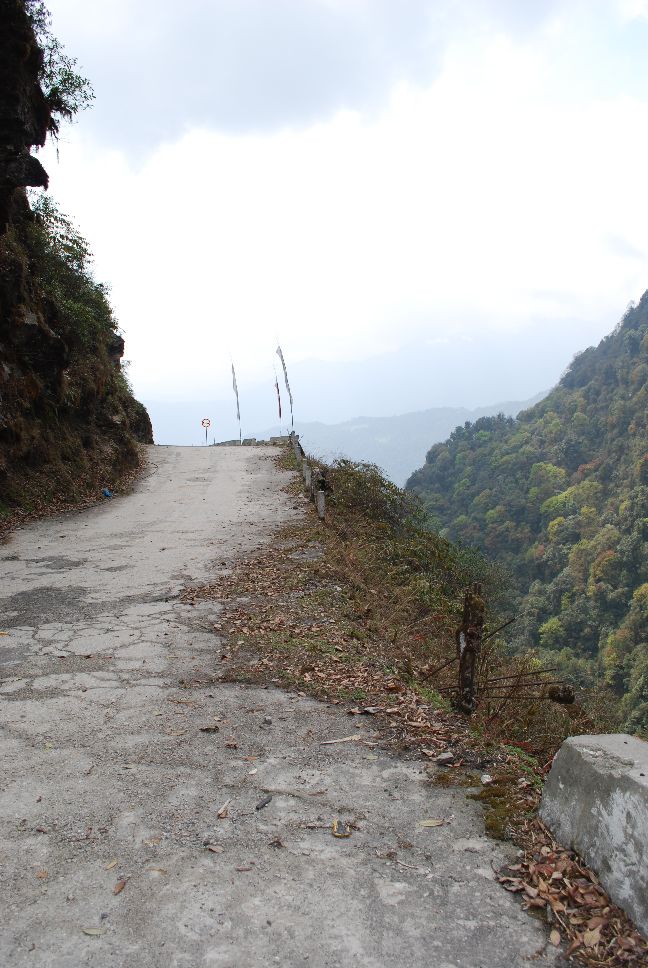
The destination for the first day was Bumthang in central Bhutan. Morten writes in his blog about their meeting with Gembo, a former pupil of Einar, who lives at Bumthang:
"We are staying at a Swiss guesthouse which is now run by a Bhutanese. The rooms are clean and orderly. It's cold outside, and in each room there is a fire. The dinner is of a high standard: potatoes, rice, vegetables and meat. Gembo Tenzin, a former pupil of Reidun and Einar lives in Bumthang. We went to greet him. In the fifth grade he was collecting apples. A bear was out on the same mission. There was fighting and Gembo received major injuries to his face and was blinded. A project run by the Swiss organization Helvetas took care of the little boy, and he was taken to Switzerland to remedy some of his facial injuries. Then he came to the school for the Blind. After some years he started to work in the Swiss project. When this was privatized Gembo decided to start up his own business selling car and bike parts."
The project was later sad to learn that Gembo's business had been destroyed in a fire, and with no insurance, he now has little to support his wife and four children. It is hoped that a way will be found to support them.
Weather conditions on their journey were sometimes wintry with snow, sleet and fog. The drive was long and tiring but along the way Einar and Reidunn were able to entertain with many stories and interesting facts about the country.
On their arrival in Khaling the group received a very warm welcome :
"As we approached Khaling there were faces we recognized at the roadside. They had lit a fire and served coffee and cakes. And we got to taste momo, a sort of small pancake filled with vegetables and spices. It tasted heavenly! "
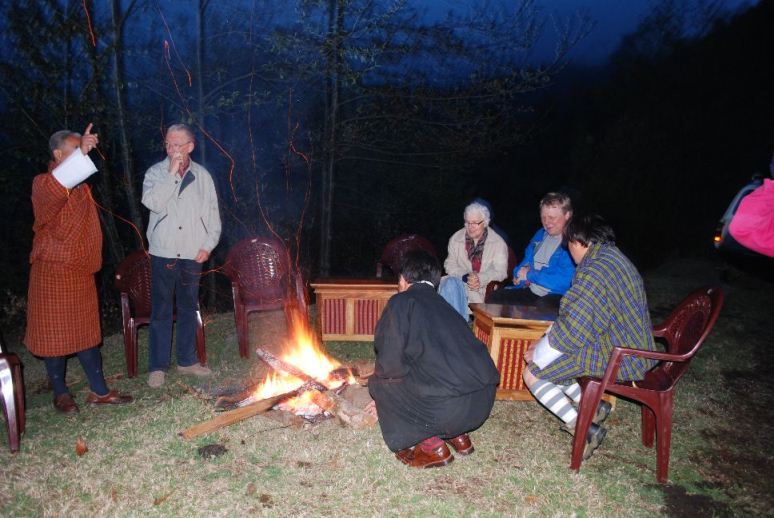
On the following day Are and Morten started work on the installation of the computer centre. Twelve desktop computers were installed with standard software (Microsoft Office 2007 and anti virus software) together with Jaws screen reading software and Magic screen magnification software. In addition a computer with software for scanning documents was installed, one with audio editing software, and a Talking Tactile Tablet with a world atlas from National Geographic was also set up. A printer was installed. The server, hard drives for backup, and a wireless network were also set up, and equipment for CD-production.
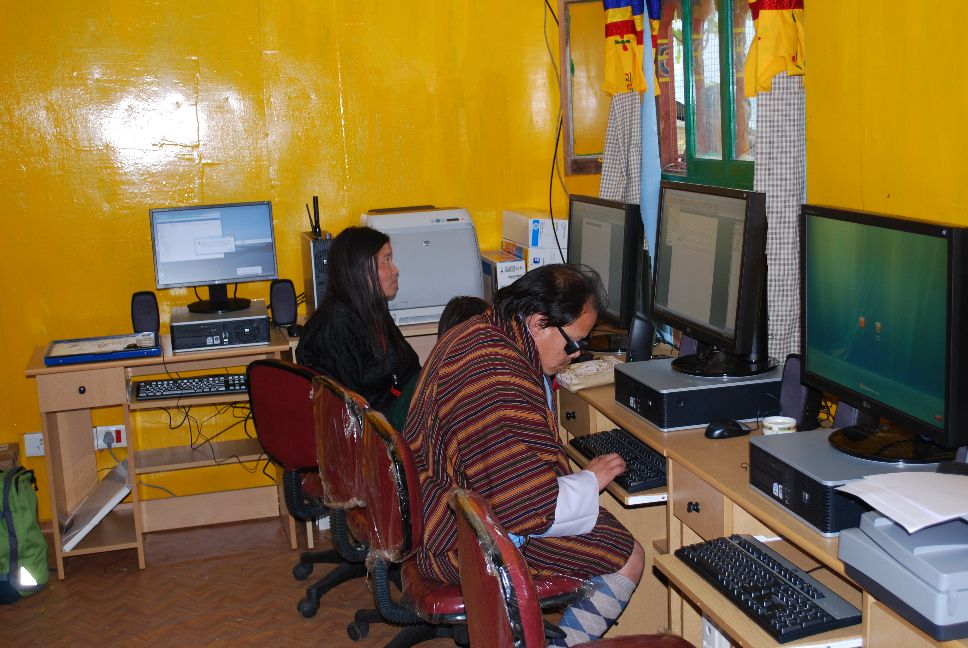
A good Internet connection (1 Mbps) was essential for these installation procedures and for later updates to the software. The best solution in such mountainous terrain was a wireless connection. The installation, equipment and operation of the wireless connection were financed by the project.
Utah Tech, the hardware supplier, was present throughout the installation and co-operated well with MediaLT. They were eager to learn more about assistive technologies. There was some trouble with the power supply shutting down, which caused two of the computers to crash often. The server also shut down every time the power went down, even though they had mounted an UPS (uninterrupted power supply) and a power stabilization unit. The problem with the power supply made it difficult to register the Jaws, Magic, and Microsoft licences. Fortunately Utah Tech were able to replace the power stabilization unit with a new one which solved the problem.
Utah Tech continued to provide on-site technical support to the centre for an eighteen month period after the installation, travelling to Khaling (a four day journey there and back again) if major problems arose.
Official opening.
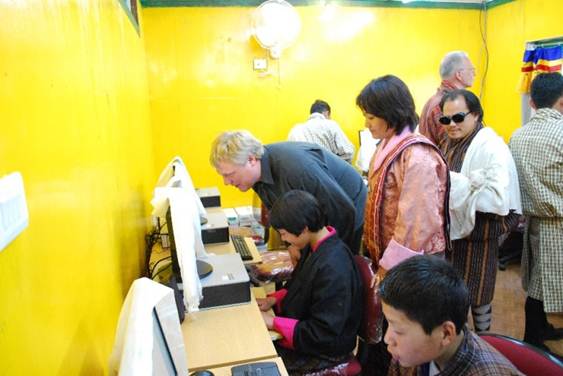
Thursday, April 10th was the day of the official opening of the computer centre and this was celebrated in true Bhutanese ceremonial style. A white carpet was laid up to the entrance of the computer centre and the computer screens were draped in white ribbons. The guests attended in their finest saris.
Einar was invited as guest of honour at this ceremony in recognition of his long association with the school. From all around the local area people gathered to celebrate the occasion, children at the school, teachers, Principals from neighbouring schools and other guests were present. The ceremony opened with a fine rendering of the Bhutanese national anthem by children, teachers and guests. The Principal of NIVI, Tshongpen Wangdi, gave a speech in which he welcomed the new employment opportunities which would be created by the acquisition of computer skills. Einar and Morten continued on this theme, talking about the new knowledge and creativity the centre would bring.
After the official ceremony was over, the children went into the computer centre and under the instruction of members of the resource group, they were able to use the computers for the very first time.
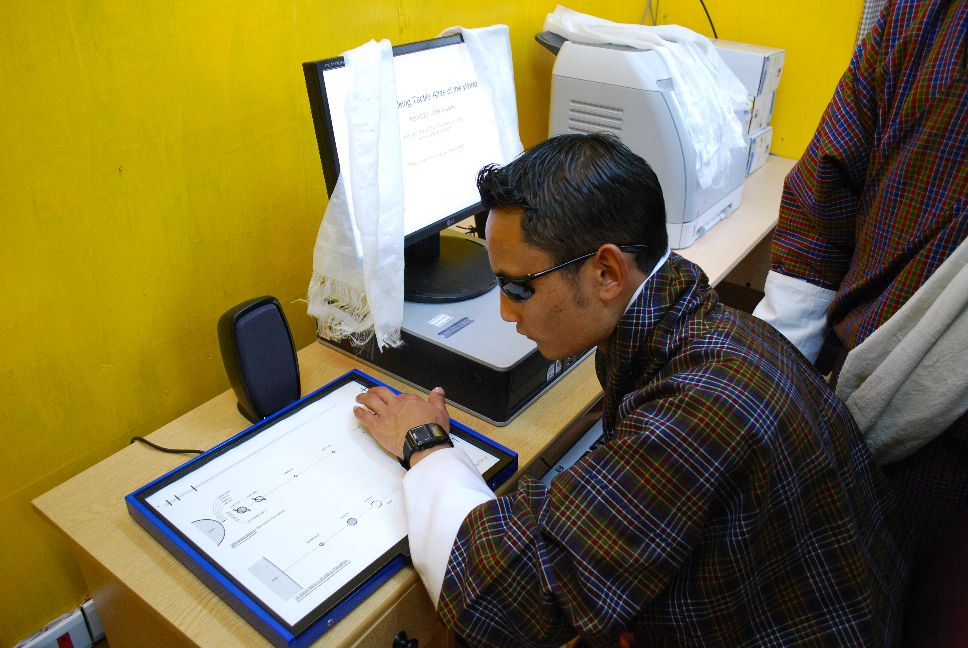
The Bhutanese broadcasting company, BBS, covered the event.
Video of the opening ceremony.
Everyone at the school was invited to a party in the evening when the children sang songs composed by Kelzang.
Future management of the computer centre.
A meeting was held at the Institute near the end of their stay in Khaling. Present at this meeting were Rinsin Pam from the Department of School Education, the Principal of NIVI, Tshongpen Wangdi , the members of the resource group in Khaling and the Norwegian visitors. The responsibilities of the various members in the resource group were discussed, in particular there was much discussion about the role of Leki Zangmo. It was the intention of the project that Leki should have the main responsibility for managing the computer centre. It had been expected that Leki would be given time off from her teaching responsibilities during the installation of the computer centre. Are and Morten expressed the opinion that Leki's role should include responsibility for management of the computer centre, with responsibility for updating software, hardware maintenance, and managing the server and network.
In the following year, however, at a meeting at the Department of Education in Thimphu in January 2009, it was proposed that Leki should be assigned a new position at Jigme Sherubling Higher Secondary School as ICT instructor for the visually impaired in classes 11 and 12. During this year the resource group at NIVI was extended to include two new members who were assigned responsibility for managing the computer centre. They were Wangchuk and Shriman Gurung.
Computer centre in the West.
A smaller computer centre was set up in Paro at Drukgyel Secondary High School. Three computers, similar to those in Khaling were installed. There were some problems with the Internet connection but these were easily resolved after consultation with the Internet supplier DrukNet.
Pema Chhoygel was responsible for managing this computer centre, and for giving training and support to visually impaired students and adults in the Western region.
Development of the computer literacy programme for classes 1 to 8 by the resource group.
When Einar, Morten and Are were in Thimphu in Spring 2008, a meeting was held with the Department of School Education to discuss the progress of the project. It was agreed that the resource group should now start the work to develop the ICT curricula for classes one to eight at NIVI, and that the proposed curricula should be presented to the Department of Education at a workshop in the summer.
Kuenga Chhoegyel, Tshering Lhamo and Kelzang Dorji were given the main responsibility for ICT teaching at NIVI and the development of the ICT curricula. Leki Zangmo and Pema Chhogyel would assist and comment on the drafts via e-mail.
The summer workshop at NIVI in July 2008 was attended by all the resource group members who had been in Norway, except Tshering Lhamo who could not join because of her summer coaching camp at Samtse. Karma Jurmi, programme officer for school ICT, and Ugyen Dorji, ICT Curriculum Officer at the Department of Education, joined the workshop. Staff from the lower and higher secondary schools in Khaling were also present. The development of the curricula was completed at this workshop and given preliminary endorsement by the Department of Education.
During August 2008 pilot teaching of the ICT curricula commenced at NIVI. It was later agreed that evaluation of the ICT teaching and curricula should continue throughout 2009 and 2010. ICT handbooks for classes 1 to 8 were developed at summer workshops in 2009 and 2010.
Example of an ICT curriculum: class 1.
Shriman Gurung and Wangchuk later joined the ICT teaching group in 2009.
In 2011 the resource group was further extended to include three other teaching staff at NIVI, Tandin Wangdi, Phuntsho Lhamo and Kumari Gurung.
Vocational ICT course for adults.
Following the work on the school curricula, the resource group started work to develop an ICT curriculum for a vocational course for visually impaired adults, most of whom were in study and / or employment situations. The in-service curriculum was completed by January 2009 when the first ICT course for adults was held at NIVI. The four week course, attended by ten adults, was organized and run by the resource group in collaboration with the Department for Special Education. Similar courses were then held annually in January 2010, 2011 and in 2012.
Laptops with standard Office software and assistive software were provided for all course participants by the project. They retained the use of their laptop in their study / employment situation after the course and received follow-up technical support from Utah Tech and from the resource group.
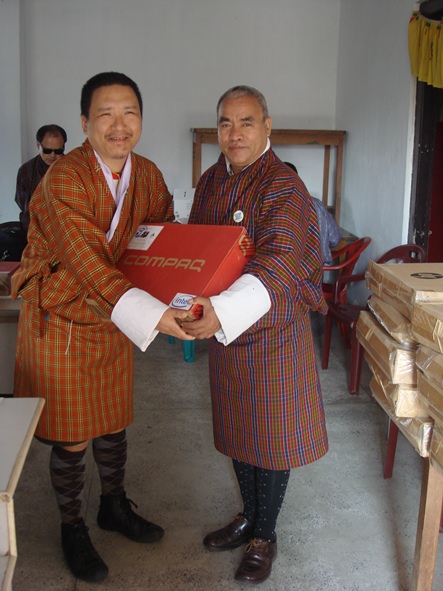
The first course in 2009 in Khaling was attended by eight men and two women, all of whom were blind or severely visually impaired. They were college students or teachers and there was one office assistant, ages ranged from 22 to 45 years. All members of the resource group took part in the teaching. This was an exciting new challenge for them and was the first time they had full responsibility for running a course with new computers, and with new beginners who had little previous experience. One of the laptops was not functioning well but Utah Tech helped to solve this problem.
Trond Ausland and Bjørn Gulbrandsen from MediaLT, accompanied by Einar, travelled to Bhutan in January 2009.

They were present during the second half of the in-service ICT course at NIVI. During this time they were able to observe the teaching and found that the course was progressing satisfactorily and that students were pleased with what they had achieved so far.
Tshering Phuntsho, one of the course participants, commented:
"I had no knowledge at all about computers before this course, so this has helped me a lot. The course has been very good and the teachers are very knowledgeable. I’m very happy to participate in this course."
Bjørn and Trond were on hand to help solve any problems and for the evaluation after the course. The resource group took full responsibility for the teaching.
In 2010 the venue for the course moved further south to Galegphug Higher Secondary School, a popular location with a warmer climate. Participants were of a similar age to those on the first course, again predominantly male with two ladies, and a greater variation in occupations: telephone receptionist, physiotherapist, teacher, counsellor, programme coordinator and assistant lecturer. Sanga, one of Einar's former pupils and now head of the physiotherapy programme in Paro, was present. As on the earlier course, it was necessary to divide the students into smaller groups. Topics covered by the course included file management, word processing and web surfing and e-mail for inexperienced users. Advanced users became familiar with more complicated spreadsheet functions and were able to present slide shows by the end of the course.
Roar Nordby and Johan Finstadsveen from MediaLT and Einar travelled to Gelephu and were present during the course. During their stay Roar and Johan had ample opportunity to get to know the course participants. At the weekend they took a trip to a local hot spring, known for its healing properties. Johan wrote in his blog:
"This was a good possibility for us to talk and get to know the other students and teachers. On the way back we stopped at the riverside and had a wonderful lunch under the open sky. The meal was rice, pork and a lot of other types of food that I cannot name. On the road back to the school, there was a fantastic spirit in the bus, and all the students and teachers were singing. "
They took a more active teaching role, holding classes in Excel and PowerPoint for more advanced students. They also demonstrated assistive technology to the two new members of the resource group, Shriman Gurung and Wangchuk, using virtual machines so the novices could practise installing and configuring the software as much as they needed. Computer viruses and the risks of pirate copying, a common practice in Bhutan, were also discussed.
Participants on the third course in 2011 were even more varied, also with respect to their level of computer skills prior to the course. They included telephone receptionists, a physio technician, teachers and a Buddhist monastic lama. The more advanced users were looking to improve specific ICT skills useful in their employment situation. Three other participants with particular needs were given one-to-one tuition while the remaining seven followed the original programme.
New school buildings at NIVI.
During their stay at the Institute in Khaling in 2008 and 2009, the Norwegian visitors expressed concern about the general state of the school buildings and living conditions for the internees.
Morten had referred to these concerns in several entries in his blog in 2008:
"Are and I are sleeping at the school. ...The bed linen is not clean ...the sink in the toilet is dirty. Everything is worn here. With a lot of muscle power, and I mean a lot, I closed the door to the room ... "
"We have heard children crying at night. Tonight, it was impossible not to do anything. Are and I went upstairs to the boys' dormitory. There was a small boy sobbing. No one at the school understands his language so he cannot talk to anyone. The boy lay in a bed that was in a terrible state. The mattress was completely soiled, and both the sheets and pillows were missing. Other beds were the same. We had, of course, to pursue this matter. Later in the week the mattress was cleaned and it seemed as if the boy was a little better cared for. He has fused fingers and his eyes are missing. He is soon to be operated on. We understand that he is a very intelligent boy, and we hope that all goes well for him after the surgery.
"Conditions at the boarding school are bad ....... yet the building is only three years old ...And the thought arises: is an ICT centre right here, or are there other things that should be a priority?"
The general standard of cleanliness and the state of the school buildings had not improved when Bjørn and Trond arrived there in 2009. Bjørn wrote:
"The rooms and bathroom had not been cleaned in a long while ... The other school buildings were also in state of poor repair. The main building in which the computer centre was located had huge cracks in the walls and in the floor. The Talking Tactile Tablet was not functioning, probably because of the high level of humidity in the building."
At a meeting with the Department of Education in Thimphu in January 2009 when Einar, Trond and Bjørn were present, it was proposed that a ward for the boys' dormitory should be employed. The availability of funds for the renewal of school buildings was also discussed
Work on a new Administration building later went ahead.
The NIVI web site.
The resource group were eager to create a good informative web site for NIVI. They were in favour of outsourcing the development of the web site, as they did not feel able to create a professional looking site that would attract users outside the Institute. MediaLT held a different view, that the resource group should be closely involved in the development of the site under the guidance of MediaLT. In this way they could ensure that the site was accessible for visually impaired users and it would be simpler for them to manage the site after the end of the project.
In December 2010 Kuenga, Kelzang, Shriman and Wangchuk attended an online course run by staff at MediaLT, with the goal of developing the web site. It has to be said that most of this development work was in the end done by MediaLT. Some aspects, for example the design of appropriate style sheets, proved to be too complex to work with in a distance learning situation. Template pages were created by MediaLT which members of the resource group later successfully used to add new content to the site. They were very pleased with the result.
There was great enthusiasm when the NIVI web site was officially launched in May 2011, to coincide with the National Teachers Day. All the members of the resource group and Einar, Nils and Magne were present. They had travelled to Khaling as part of the project evaluation.
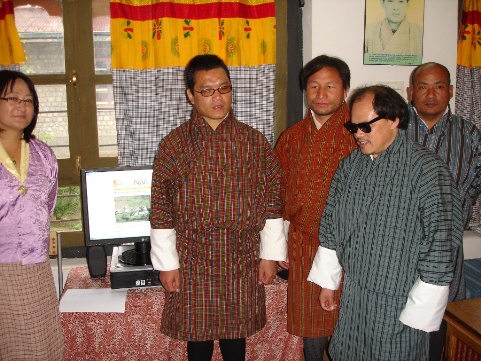
The web site was further developed throughout 2011, with online assistance from MediaLT.
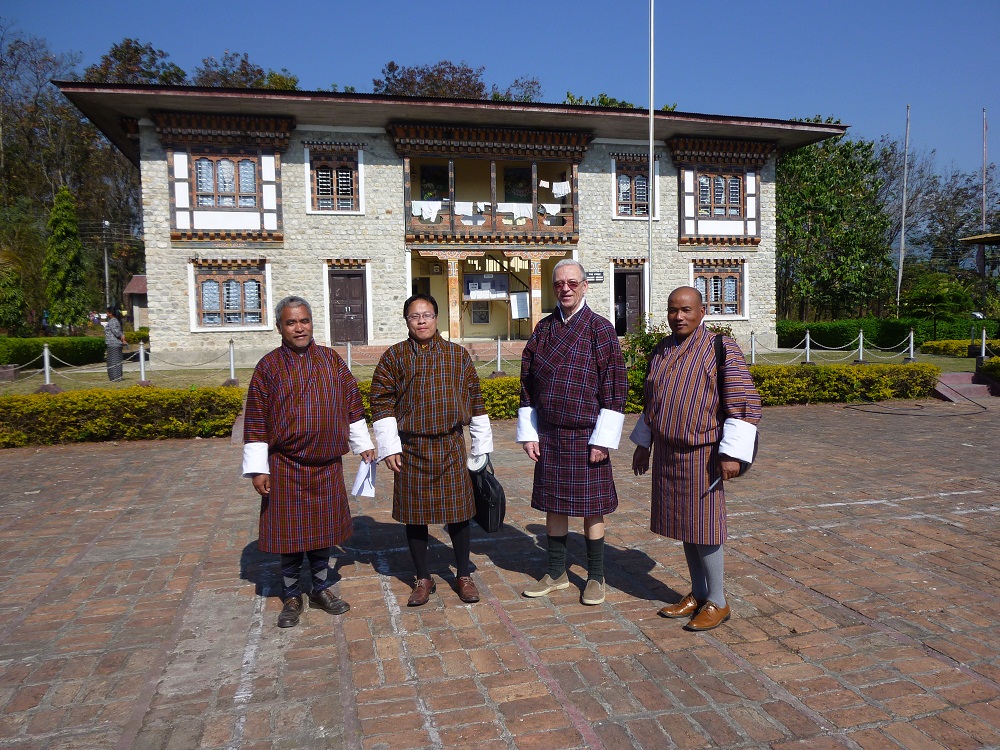
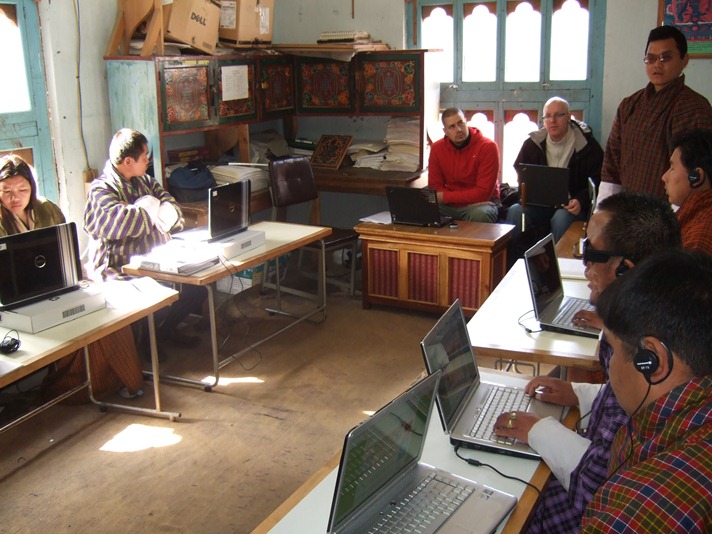
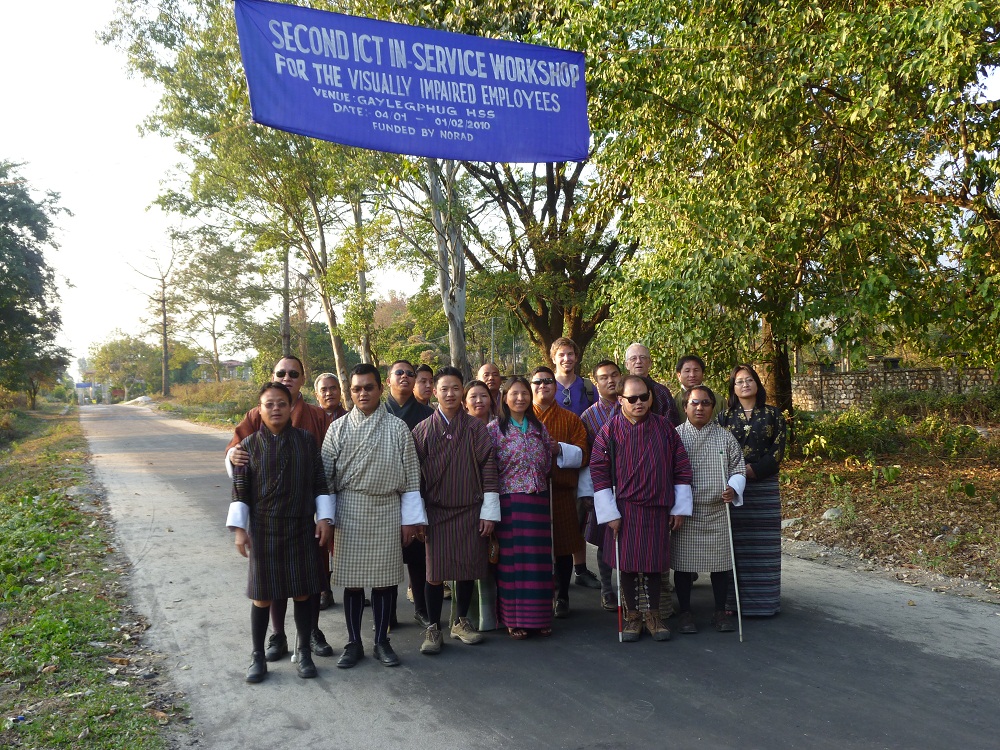

Tips noen om siden